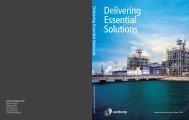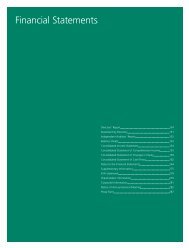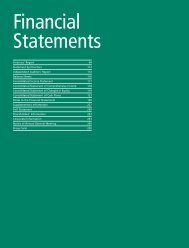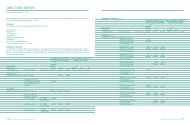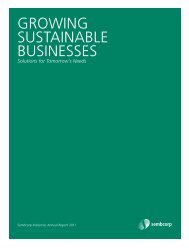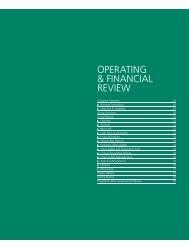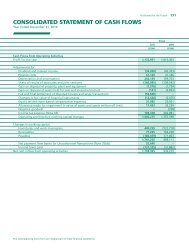FINANCIAL STATEMENTS (Full Version) - Sembcorp
FINANCIAL STATEMENTS (Full Version) - Sembcorp
FINANCIAL STATEMENTS (Full Version) - Sembcorp
You also want an ePaper? Increase the reach of your titles
YUMPU automatically turns print PDFs into web optimized ePapers that Google loves.
Notes to the<br />
Financial Statements<br />
Year Ended December 31, 2008<br />
2. SUMMARY OF SIGNIFICANT ACCOUNTING POLICIES<br />
a. Basis of Preparation<br />
The financial statements are prepared in accordance with Singapore Financial Reporting Standards (“FRS”).<br />
The financial statements are presented in Singapore dollars and rounded to the nearest thousand (“S$’000”),<br />
unless otherwise indicated. They are prepared on the historical cost basis except where otherwise described in the<br />
accounting policies below.<br />
The preparation of financial statements in conformity with FRS requires management to make judgements,<br />
estimates and assumptions that affect the application of accounting policies and reported amounts of assets,<br />
liabilities, income and expenses. Actual results may differ from these estimates.<br />
The estimates and underlying assumptions are reviewed on an ongoing basis. Revisions to accounting estimates are<br />
recognised in the period in which the estimates are revised and in any future periods affected.<br />
Information about significant areas of estimation uncertainty and critical judgements in applying accounting<br />
policies that have the most significant effect on the amount recognised in the financial statements are discussed<br />
in Note 43.<br />
With effect from January 1, 2008, the Group adopted the following new or amended FRS and Interpretations to<br />
FRS (“INT FRS”) which are relevant to the Group’s operations:<br />
INT FRS 111<br />
INT FRS 114<br />
FRS 102 – Group and Treasury Share Transactions<br />
FRS 19 – The Limit on a Defined Benefit Asset, Minimum Funding Requirements<br />
and their Interaction<br />
The adoption of the above INT FRS did not result in substantial changes to the Group’s accounting policies. The<br />
accounting policies set out below have been applied consistently by the Group. The accounting policies used by the<br />
Group have been applied consistently to all periods presented in these financial statements.<br />
b. Consolidation<br />
i. Subsidiaries<br />
Subsidiaries are those companies that are controlled by the Group. Control exists when the Group has the<br />
power, directly or indirectly, to govern the financial and operating policies of a company so as to obtain<br />
benefits from its activities.<br />
The existence and effect of potential voting rights that are presently exercisable or presently convertible are<br />
considered when assessing whether the Group controls another company.<br />
Investments in subsidiaries are stated in the Company’s balance sheet at cost less impairment losses. The<br />
financial statements of subsidiaries are included in the consolidated financial statements from the date that<br />
control commences until the date that control ceases.<br />
All business combinations are accounted for using the purchase method with effect from January 1, 2004<br />
upon the adoption of FRS 103. Prior to January 1, 2004, business combinations were accounted for either by<br />
the purchase method, or if they were between entities under common control, by the historical cost method<br />
similar to the pooling-of-interest method.<br />
2. SUMMARY OF SIGNIFICANT ACCOUNTING POLICIES (cont’d)<br />
b. Consolidation (cont’d)<br />
i. Subsidiaries (cont’d)<br />
Under the purchase method, the cost of an acquisition is measured at the fair value of the assets given, equity<br />
instruments issued and liabilities incurred or assumed at the date of exchange, plus costs directly attributable<br />
to the acquisition. The excess of the Group’s interest in the net fair value of the identifiable assets, liabilities<br />
and contingent liabilities over the cost of acquisition is credited to the income statement in the period of the<br />
acquisition.<br />
ii.<br />
Business combinations that involve entities under common control are excluded from the scope of FRS 103. Such<br />
combinations are accounted at historical cost in a manner similar to the pooling-of-interests method, in the<br />
preparation of the consolidated financial statements. Under this method of accounting, the difference between<br />
the value of the share capital issued and the value of shares received is taken to the merger reserve.<br />
The interest of minority shareholders is stated at the minority’s proportion of the fair values of the assets and<br />
liabilities recognised. Subsequently, any losses applicable to the minority interest in excess of the minority<br />
interest are allocated against the interests of the parent.<br />
Associates<br />
Associates are companies in which the Group has significant influence, but not control, over the financial and<br />
operating policies.<br />
The existence and effect of potential voting rights that are presently exercisable or presently convertible are<br />
considered when assessing whether the Group has significant influence over another company.<br />
In the Group’s financial statements, they are accounted for using the equity method of accounting from the<br />
day that significant influence commences until the date that significant influence ceases. When the Group’s<br />
share of losses exceeds the carrying amount of the associate (including any other unsecured receivables,<br />
that in substance, form part of the Group’s net investment in the associate), recognition of further losses is<br />
discontinued unless the Group has incurred obligations or made payments on its behalf to satisfy obligations<br />
of the associate that the Group has guaranteed or otherwise committed on behalf of.<br />
The excess of the Group’s interest in the net fair value of the identifiable assets, liabilities and contingent<br />
liabilities over the cost of acquisition is credited to the income statement in the period of the acquisition.<br />
Where the audited financial statements are not available, the share of results is arrived at from unaudited<br />
management financial statements made up mainly to the end of the accounting year to December 31.<br />
iii. Joint Ventures<br />
Joint ventures are those enterprises whose activities the Group has joint control over, established by contractual<br />
agreement.<br />
The existence and effect of potential voting rights that are presently exercisable or presently convertible are<br />
considered when assessing whether the Group has joint control over the enterprise.<br />
For incorporated joint ventures, the Group accounts for the joint ventures in the same manner as associates,<br />
from the date joint control commences until the day that the joint control ceases.<br />
For unincorporated joint ventures, the proportionate share in the unincorporated joint ventures’ individual<br />
income, expenses, assets and liabilities are included in financial statements of the Group with items of a similar<br />
nature on a line-by-line basis.<br />
120 Delivering Essential Solutions <strong>Sembcorp</strong> Industries Annual Report 2008 121



